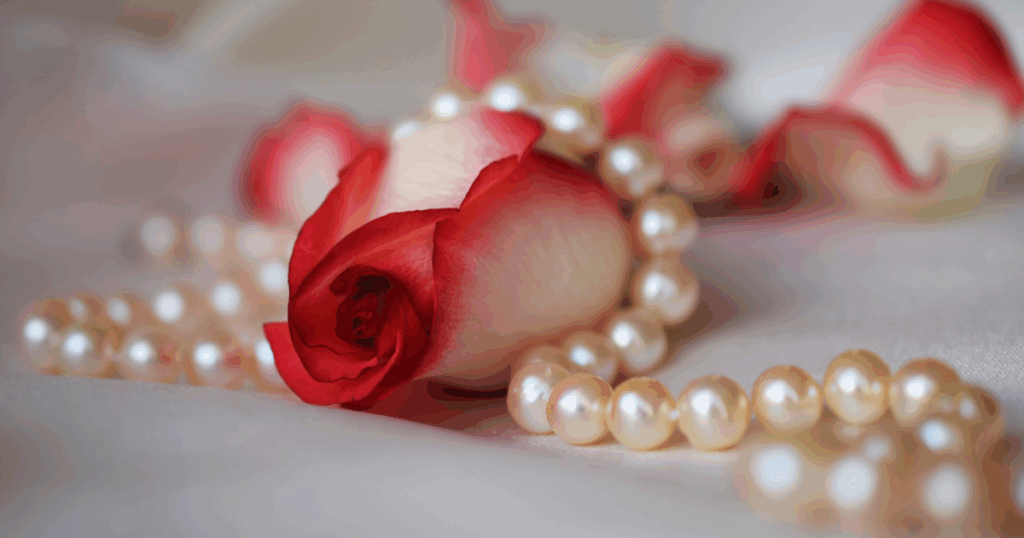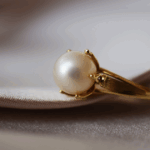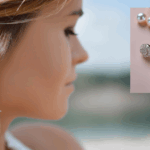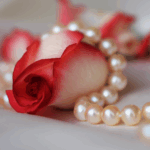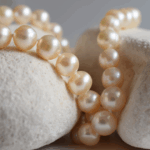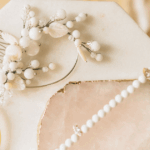Is Your Heirloom Pearl Necklace Actually Real?
That shimmering strand of pearls. A gift? An heirloom? Is it the real deal?
The definitive real vs fake pearl necklace test involves a combination of simple, at-home methods. The most reliable is the “Tooth Test,” where a real pearl feels slightly gritty against your tooth, while a fake is perfectly smooth. Other key indicators include the pearl’s weight (real pearls are heavier than fakes), temperature (real pearls are cool to the touch), and a close inspection of the drill holes, which are sharp and clean on genuine pearls but often messy on imitations.
What Makes a Pearl “Real” Anyway?
Before we dive into playing jewelry detective, let’s get our terms straight. What does “real” even mean in the world of pearls? It’s a bit more nuanced than you might think. For most people, “real” encompasses two main categories: natural pearls and cultured pearls. Both are created by mollusks and possess the organic, iridescent beauty we associate with this classic gem. The difference lies in how they got started. Understanding this distinction is the first step in appreciating the story your necklace tells.
Natural vs. Cultured: The Ocean’s Treasures
Imagine, over a century ago, a diver plunging into the depths of the Persian Gulf, holding their breath, searching for oysters. This was the dangerous and rare pursuit of natural pearls. A natural pearl is a true accident of nature. It forms when a tiny irritant, like a grain of sand or a parasite, coincidentally works its way inside a mollusk (an oyster or a mussel). As a defense mechanism, the mollusk secretes layers upon layers of a substance called nacre (pronounced NAY-ker). This nacre, composed of aragonite and conchiolin, builds up over years, forming a luminous pearl. Because this process is entirely up to chance, natural pearls are incredibly rare and, consequently, astronomically expensive. Finding a full necklace of perfectly matched natural pearls is like winning the lottery a dozen times over. Most are now found in antique and vintage jewelry.
Now, let’s talk about cultured pearls. In the early 20th century, pioneers like Kokichi Mikimoto in Japan perfected a technique to give Mother Nature a little nudge. In this process, a skilled technician carefully implants a small bead (often made from shell) and a piece of mantle tissue into the mollusk. This acts as the irritant, kick-starting the nacre-secreting process. The mollusk then does the rest of the work, coating the nucleus with nacre just as it would in the wild. These are not “fake” pearls; they are genuine pearls facilitated by human intervention. The vast majority of real pearl jewelry sold today, from Akoya and South Sea to Tahitian and Freshwater, consists of cultured pearls. They are still precious organic gems, just made more accessible through science and aquaculture.
The Luster and Nacre Connection
The magic of a pearl lies in its luster, that deep, inner glow that seems to emanate from within. This isn’t just a surface shine; it’s a complex interplay of light with the layers of nacre. Think of nacre as microscopic, translucent crystals stacked like bricks. When light hits the pearl, it penetrates these layers, reflecting and refracting off each one. This is what creates the soft, shimmering glow and the subtle rainbow-like “orient” or overtone. The quality and thickness of the nacre directly determine the quality of the luster. A pearl with thick, high-quality nacre will have a sharp, brilliant luster, where you can see your reflection clearly.
Imitation pearls, on the other hand, simply can’t replicate this. They are typically made from a glass, ceramic, or plastic bead that is then coated with a pearlescent varnish or lacquer. This coating provides a surface shine, but it lacks depth. The light just bounces off the top layer. It might look shiny, but it won’t have that captivating inner glow. Understanding that nacre is the very soul of a real pearl is fundamental to spotting a fake. Every test we’re about to discuss is, in one way or another, a method of detecting the presence or absence of this unique, organic substance.
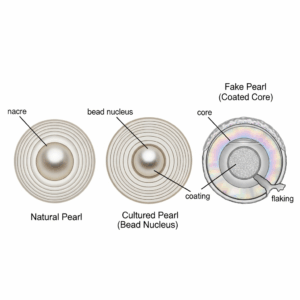
The Famous (and Infamous) Tooth Test
Alright, let’s get to the most well-known, hands-on method: the tooth test. This is the go-to quick check for everyone from pawn shop owners to grandmothers sorting through their jewelry boxes. It sounds a bit strange, but it’s remarkably effective because it relies on the unique physical properties of nacre. It’s a test of texture, and it can often give you an answer in seconds. But before you go chomping down on a precious heirloom, there’s a right way to do it.
How to Perform the Tooth Test Safely
First things first: you are not biting the pearl! Please, do not do that. You risk damaging the pearl and, more importantly, your dental work. The goal is to feel the texture, not test its durability. Make sure the pearl is clean; a quick wipe with a soft cloth will do. The test uses the enamel on your teeth, which is surprisingly sensitive to minute textural differences.
Here’s the safe and proper technique:
- Hold a single pearl from the strand firmly between your thumb and forefinger.
- Gently rub it—don’t scrape it—against the biting edge of one of your front teeth. Move it back and forth lightly.
- Pay close attention to the sensation. What do you feel?
That’s it. It’s a subtle test. If you’re unsure, try it with a known fake pearl first (like a bead from a piece of costume jewelry) to get a baseline for “smooth.” Then, test the pearl in question. This comparison will make the difference immediately obvious. Don’t perform this test if you have veneers or other cosmetic dental work on your front teeth, as you won’t be able to feel the texture properly. In that case, you can try rubbing two pearls from the same necklace against each other; real pearls will create a slight friction, while fakes will glide smoothly.
What You’re Feeling For: Grit vs. Smooth
So, what exactly are you hoping to feel? A real pearl, whether natural or cultured, will feel slightly gritty or sandy. This is because nacre is made of microscopic aragonite crystals. Even though the pearl feels smooth to your fingertips, the hyper-sensitive surface of your tooth enamel can detect the edges of these tiny, overlapping platelets. It’s not a rough, sandpaper-like feeling, but a fine, distinct grittiness. Think of the texture of fine mineral makeup powder. This grittiness is the telltale sign of authentic nacre.
A fake pearl, on the other hand, will feel perfectly, almost unnaturally, smooth. Whether it’s glass, plastic, or ceramic coated with a pearlescent solution, the surface is uniform and man-made. Rubbing it against your tooth will feel like rubbing a tiny marble or a piece of plastic. There’s no texture, no friction, no grit whatsoever. It will just glide effortlessly. This dead-smooth feeling is a dead giveaway for an imitation. The tooth test is beloved for a reason: it’s quick, requires no special equipment, and directly tests for the organic structure that defines a genuine pearl. It’s your first and often most conclusive step in the real vs fake pearl necklace test.
The Weight and Temperature Test: Feel the Difference
Our sense of touch is an incredibly powerful tool, and it can tell us a lot more about a pearl necklace than just its surface texture. Two of the most intuitive yet often overlooked tests are the weight test and the temperature test. These methods require no equipment, just your hands and a bit of focused perception. They tap into the fundamental differences in density and thermal conductivity between an organic gem and its man-made counterparts. While not as definitive as the tooth test on their own, they provide strong supporting evidence.
Hefting for Authenticity: Real Pearls Have Heft
Have you ever picked up a piece of solid wood furniture and been surprised by its weight compared to a particleboard equivalent? The same principle applies here. Real pearls have a surprising density. Nacre is a compact substance, and a strand of genuine pearls will feel noticeably heavier than it looks.
To perform this test, simply hold the pearl necklace in your palm. Bounce it gently. Get a feel for its weight and substance. Now, if you have a known fake or costume pearl necklace, try the same thing. The difference is often striking. Imitation pearls, especially those with a plastic core, will feel light, airy, and almost cheap in comparison. They lack the satisfying heft of a genuine strand. Even glass-based fakes, which are heavier than plastic ones, often don’t quite match the specific gravity of real nacre. This test is most effective when you can make a direct comparison, but even without a reference, your intuition can be a good guide. If a long, substantial-looking necklace feels feather-light, it’s a major red flag. This sensation of density is a subtle but consistent characteristic of real pearls.
The Cold Touch: A Telltale Sign
This is another simple yet remarkably effective test. Real pearls are organic gems formed in water, and they have excellent thermal conductivity. This means they are very good at dissipating heat. As a result, genuine pearls will feel cool, sometimes even cold, to the touch when you first pick them up. They take a few moments to warm up against your skin.
To try this, make sure the pearls have been sitting out at room temperature for a while (not in a sunbeam or right after you’ve worn them). Pick them up and press them against a sensitive part of your skin, like your cheek or the inside of your wrist. They should feel distinctly cool. Plastic imitations, being insulators, will feel much closer to room temperature and will warm up almost instantly. Glass fakes can be tricky as glass can also feel cool, but it often warms up faster than a real pearl. The cool touch of a real pearl is a signature trait. It’s that little shiver of authenticity you feel when you first put on a real strand. Combining this temperature clue with the weight test gives you a powerful, two-pronged sensory evaluation before you even look at the finer details.
The Visual Inspection: Your Eyes Don’t Lie
After the tactile tests, it’s time to use your most powerful analytical tool: your vision. A careful visual inspection can reveal a wealth of information about a pearl’s authenticity. This isn’t about a quick glance; it’s about looking closely and understanding what you’re seeing. Fake pearls are designed to look perfect from a distance, but up close, their uniformity and lack of organic character become their downfall. Real pearls, on the other hand, celebrate their unique, natural origins through their luster and subtle imperfections.
Examining the Luster and Overtone
We touched on luster earlier, but it’s worth a deeper dive. Luster is the single most important factor in a pearl’s beauty and value, and it’s the hardest thing for fakes to replicate. Hold the necklace under a good light source—natural daylight is best. Look at how the light plays on the surface of the pearls.
A real pearl’s luster is deep and complex. It’s not just a surface shine; it’s a glow that seems to come from within. The reflection on a high-quality real pearl will be bright and sharp, with clear, distinct edges. You should be able to see a distorted reflection of yourself and your surroundings. Also, look for the “overtone” or “orient.” This is the subtle secondary color that seems to float over the main body color of the pearl, often a hint of rose, green, or cream. This phenomenon is caused by the refraction of light through the many layers of nacre.
Now, look at a fake pearl in the same light. The shine is often one-dimensional. It might be very bright and glassy, or it might be dull and chalky, but it will lack depth. The reflection will be flat and painted-on, without the crispness of a real pearl. It won’t have that complex, layered overtone. The light simply bounces off the artificial coating. This difference between a deep, inner glow and a superficial shine is one of the most reliable visual clues in the real vs fake pearl necklace test.
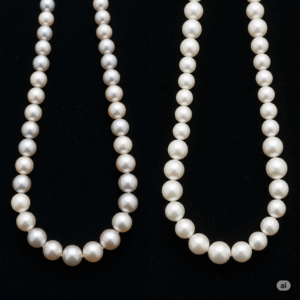
Perfection is a Red Flag: The Beauty of Imperfection
In a world obsessed with flawlessness, pearls are a beautiful exception. Since real pearls are organic gems created by a living creature, they are rarely perfect. Each one is unique. When you inspect a strand of genuine pearls, you’ll notice slight variations from one pearl to the next. They might differ slightly in size, shape (even “round” pearls are rarely perfect spheres), and surface texture. You may even see tiny blemishes, pits, or rings on their surface. These are not flaws; they are birthmarks, signs of their authentic origin.
Now, examine a strand of imitation pearls. What do you see? Perfection. Every “pearl” is identical to its neighbor. They are all the exact same size, the exact same shape, the same color, and have the exact same flawless surface. This machine-made uniformity is a dead giveaway. Nature doesn’t work on an assembly line. So, if the necklace you’re holding looks too good to be true, it probably is. Embrace the subtle imperfections and variations in a real pearl necklace; they are the fingerprints of its authenticity and a key part of its character and charm.
A Closer Look: The Drill Hole Test
Now it’s time to get up close and personal. Really close. For this test, you’ll need some form of magnification—a simple magnifying glass, a jeweler’s loupe, or even the zoom function on your smartphone camera can work in a pinch. We are going to examine one of the most revealing parts of a strung pearl: the drill hole. The way a pearl responds to being drilled is fundamentally different from how a coated bead responds, and this difference provides a wealth of clues.
What Magnification Reveals About the Hole
Focus your magnifier on the area where the string enters and exits the pearl. On a genuine pearl, you should see a clean, sharp, well-defined drill hole. The edges of the hole should look crisp and neat. You might see the nacre layers in cross-section, looking like concentric rings, though this can be difficult to spot without high-powered magnification. The key takeaway is that nacre is a strong, cohesive material. When drilled, it tends to create a clean bore, much like drilling through a piece of hardwood.
Now, turn your attention to the drill hole of a suspected fake. It often tells a very different story. Imitation pearls are typically a base bead (glass or plastic) covered with a coating. When this is drilled, the coating around the hole tends to chip, flake, or peel back. Instead of a sharp, clean edge, you’ll often see a messy, slightly raised, or concave rim around the hole. It can look like the paint around a hole drilled in a painted wall. You might also notice that the pearlescent coating looks thinner or worn away right at the edge of the hole, sometimes revealing the different-colored base material underneath. This evidence of a coating being disrupted is a slam-dunk indicator of a fake.
Nacre Buildup vs. Chipped Paint
Another subtle clue around the drill hole relates to how the pearl was formed. On some cultured pearls, you might see a slight buildup or concentration of nacre around the drill hole, almost like a tiny, smooth meniscus. This is a natural part of the pearl’s formation and drilling process. It looks organic and integrated into the pearl’s surface.
On fakes, what you see is the opposite. The area around the drill hole is a point of weakness. Over time, with the friction of the string and contact with other pearls, the artificial coating is most likely to degrade here first. Under magnification, you might see tiny flakes of the “pearl” coating missing or a clear demarcation line between the coating and the bead underneath. This looks less like a natural feature and more like chipped paint or a worn finish. The drill hole is a weak link in the fake pearl’s disguise, and with a little magnification, it becomes a window into its true identity.
The Bounce Test: A Risky but Revealing Method
Before we discuss this next test, a significant word of caution is in order. The bounce test is effective, but it carries a risk of damaging the pearls, whether they are real or fake. It should absolutely be considered a last-resort method, perhaps used on a single, loose pearl of questionable origin that you’re willing to potentially sacrifice for the sake of knowledge. Do not perform this test with a full, valuable necklace. With that disclaimer out of the way, let’s explore the physics behind it.
Understanding the Physics of a Pearl’s Bounce
The bounce test leverages the difference in elasticity and density between a solid nacre pearl and its common imitations. A real pearl, with its dense, crystalline structure of nacre, has a surprising amount of bounce. If dropped from a moderate height onto a hard, flat surface like a glass countertop, it will rebound quite high.
To perform the test (cautiously!), take a single pearl and drop it from a height of about 24 inches (60 cm) onto a piece of glass. A real pearl will bounce back up to 12-15 inches (30-38 cm) or even higher. It’s a surprisingly lively rebound.
Now, try the same with a known fake. A plastic pearl, being very light and not very elastic, will barely bounce at all. A glass pearl will bounce, but typically not as high as a real pearl of the same size. Its bounce is often “deader” and less energetic. The high, crisp bounce of a real pearl is quite distinctive. This test essentially measures the coefficient of restitution of the material, which is much higher for the compact, layered nacre of a genuine pearl.
Why This Test Should Be a Last Resort
So, why the heavy warnings? First, dropping a pearl onto a hard surface can cause it to chip, crack, or fracture, especially if it has internal flaws. This is true for both real and fake pearls. You could irrevocably damage a genuine gem. Second, the stringing of a necklace is often delicate. Performing this test with a full strand could cause the string to break, sending pearls scattering everywhere—a disaster for any necklace owner. Third, the results can be subjective if you don’t have a known real and a known fake pearl to use for comparison. The height of the bounce can be hard to judge in isolation.
Given these risks, the bounce test is generally not recommended for treasured pieces. It’s more of a “curiosity” test for a loose, unidentified pearl. The other methods—the tooth test, visual inspection, and weight/temperature tests—are far safer and, when combined, just as conclusive. Stick to those non-destructive methods for any jewelry you value. Think of the bounce test as an interesting scientific principle rather than a practical, everyday tool for your real vs fake pearl necklace test.
Identifying Common Types of Fake Pearls
To be a true pearl detective, you need to know the “usual suspects.” The world of imitation pearls is vast and varied, ranging from cheap plastic beads to sophisticated, high-end fakes that can fool the untrained eye. Understanding the different types of impostors and their specific characteristics will make you much more effective at spotting them. Each type has its own telltale signs that align with the tests we’ve been discussing.
Glass Pearls: The Classic Imitation
Glass pearls are one of the oldest and most common types of fakes. They are created by using a glass bead as the core and then coating it with a solution containing fish scales (guanine) or other pearlescent lacquers to simulate luster. High-quality glass pearls can have a convincing weight and initial coolness to the touch, which can make them tricky.
However, they have several weaknesses. Their luster, while sometimes bright, is often too glassy and lacks the deep, soft glow of real nacre. Upon close inspection of the drill hole, you’ll often see the telltale chipping or buildup of the coating around the edges. Glass pearls will also feel perfectly smooth in the tooth test, which is a definitive giveaway. Over time, their coating can also be prone to peeling or scratching, revealing the glass bead beneath. They are the classic costume jewelry staple and a good first fake to learn to identify.
Plastic Pearls: The Lightweight Deceivers
These are the most common and least expensive type of imitation pearl. As the name suggests, they consist of a plastic bead dipped in a pearlescent coating. They are incredibly easy to spot once you know what to look for. Their most obvious characteristic is their weight—or lack thereof. A strand of plastic pearls feels unnaturally light, almost like a child’s toy. They also fail the temperature test spectacularly, feeling room temperature or even warm to the touch and warming up instantly in your hand.
Visually, their luster is usually very poor, looking more like paint than a real gem. The tooth test will reveal a perfectly smooth, plastic-y surface. Furthermore, the coating on plastic pearls is notoriously fragile. It scratches easily, and you can often see seams or mold marks from the manufacturing process if you look closely. While they might pass muster from across a crowded room, any hands-on inspection will quickly reveal their true nature.
Shell Pearls (Majorica): The High-End Fakes
This is where things get more interesting. Shell pearls, famously produced by the brand Majorica, are considered the “Cadillacs” of imitation pearls. They are constructed using a solid glass or composite core, which is then coated with multiple layers of a proprietary pearlescent lacquer. This process gives them a very good weight, a convincing luster, and a high degree of durability compared to other fakes. They are often marketed as “organic man-made pearls.”
So how do you spot them? It’s tougher, but not impossible. While their luster is good, it still tends to be a little too perfect and lacks the subtle orient and depth of a high-quality cultured pearl. They are also, like all fakes, perfectly uniform in size, shape, and color, which is a red flag. Most importantly, despite their sophisticated construction, they will still feel perfectly smooth against the tooth. The tooth test remains the great equalizer, able to unmask even the most convincing of impostors. Recognizing these high-end fakes is a crucial skill for any serious jewelry buyer.
The Clasp and Stringing: Clues in the Craftsmanship
Sometimes, the biggest clues about a necklace’s authenticity aren’t in the pearls themselves, but in the way they are presented. The craftsmanship of the clasp and the style of stringing can speak volumes about the quality and intended value of the piece. High-quality pearls are an investment, and jewelers typically don’t mount them with cheap, low-grade findings or shoddy workmanship. Think of it this way: you wouldn’t put cheap tires on a Ferrari.
Decoding Hallmarks on the Clasp
Take a close look at the clasp of the necklace. This small piece of metal can be a treasure trove of information. On a genuine pearl necklace, the clasp is almost always made of precious metal. Look for tiny stamps, known as hallmarks, that indicate the metal’s purity. You’ll need a magnifying glass for this.
Common hallmarks include:
- For Gold: “14K,” “18K,” “585” (for 14K gold), or “750” (for 18K gold).
- For Silver: “925,” “Sterling,” or “STER.”
- For Platinum: “PLAT,” “PT,” or “950.”
If you see these marks, it’s a very strong indicator that the pearls are real, as manufacturers wouldn’t use an expensive precious metal clasp on a cheap strand of fakes. Conversely, if the clasp has no hallmarks, feels lightweight, or shows signs of tarnishing in a way that isn’t typical for silver (like turning green, which indicates a copper base), you should be highly suspicious of the pearls’ authenticity.
The Significance of Knots Between Pearls
Now, look at the string itself. How are the pearls strung together? On a high-quality, genuine pearl necklace, you will almost always find a tiny, neat knot between each and every pearl. This practice, known as knotting, serves two crucial purposes.
First, it prevents the pearls from rubbing against each other. The continuous friction of pearls grinding together can wear down the nacre over time, damaging their luster and surface. The knots act as tiny, protective bumpers. Second, and perhaps more importantly, knotting provides security. If the necklace were to break, you would only lose one, maybe two pearls. The knots would prevent the entire strand from scattering across the floor.
Because knotting is a time-consuming and skilled process, it adds to the cost of the necklace. Therefore, it’s a feature rarely found on cheap, imitation strands. Fake pearl necklaces are usually just strung one after another on a single cord. Seeing those neat, uniform knots between the pearls is a hallmark of quality and a very strong sign that you’re holding a genuine piece of jewelry.
When DIY Isn’t Enough: Seeking Professional Appraisal
The at-home tests we’ve covered are fantastic for giving you a very strong indication of whether your pearls are real or fake. For 99% of cases, they are all you need. However, there are situations where a definitive, expert opinion is necessary. If you’re dealing with a potentially very valuable piece (especially suspected natural pearls), need an official valuation for insurance purposes, or simply want an ironclad confirmation, it’s time to call in a professional.
Finding a Reputable Gemologist
Not all jewelers are created equal. While many jewelry store employees have good general knowledge, what you need for a formal appraisal is a graduate gemologist. These are professionals who have undergone extensive training and certification in the science of identifying and grading gemstones. They have the expertise and, just as importantly, the specialized equipment to make a definitive judgment.
Look for credentials from respected institutions like the Gemological Institute of America (GIA) or the American Gem Society (AGS). A certified gemologist appraiser will provide an unbiased, expert evaluation. You can often find them at high-end independent jewelry stores or through dedicated appraisal services. Don’t be afraid to ask about their qualifications and experience specifically with pearls. A good appraiser will be transparent about their process and credentials.
What to Expect During a Professional Evaluation
When you take your pearls to a gemologist, they will go far beyond the simple tests you can do at home. They will use a variety of tools to get a conclusive answer. This may include:
- High-Powered Gemological Microscope: This allows for an extremely detailed examination of the pearl’s surface, blemishes, and, most critically, the drill hole. They can see the nacre structure in a way that’s impossible with a simple loupe.
- X-radiography: This is the gold standard for distinguishing between natural and cultured pearls. An X-ray can reveal the inner structure of the pearl. A natural pearl will show concentric growth rings, like an onion, while a cultured pearl will reveal its solid bead nucleus. This is a non-destructive way to see inside the pearl.
- Refractometer and other tools: These instruments measure how light behaves as it passes through the gem, providing data that can help confirm the material is indeed nacre.
After the examination, the appraiser will provide you with a detailed written report. This document will state definitively whether the pearls are natural, cultured, or imitation. If they are genuine, it will also include a full grading of their quality based on the “seven value factors”: size, shape, color, luster, surface quality, nacre quality, and matching. This formal document is what you would use for insurance, estate planning, or potential resale.
Does “Real” Always Mean Valuable?
So, you’ve done the tests, and you’ve confirmed your necklace is made of real, genuine pearls. Congratulations! The next logical question that pops into most people’s minds is, “So… is it valuable?” The answer is a classic “it depends.” The fact that they are real is the first and most important step, but the journey to determining value is a path with many variables. “Real” is the entry ticket; it doesn’t guarantee a high price tag.
Factors Influencing a Pearl’s Worth
A gemologist grades pearls based on a set of internationally recognized criteria. These are the key factors that determine a pearl’s market value, often referred to as the GIA’s 7 Pearl Value Factors™:
- Size: Larger pearls are rarer and more valuable, all other factors being equal. Pearl size is measured in millimeters.
- Shape: Perfectly round pearls are the most traditional and often the most valuable shape. However, well-formed symmetrical shapes like drops and ovals, as well as unique baroque shapes, can also be highly prized.
- Color: This includes the main body color (e.g., white, cream, black), the overtone (the secondary color), and the orient (the iridescent rainbow colors on the surface). Certain colors are rarer and more in demand than others.
- Luster: As we’ve discussed, this is the most critical factor. Sharp, bright luster with a deep inner glow is highly desirable and commands the highest prices.
- Surface Quality: This refers to the absence of blemishes like pits, bumps, or cracks. The cleaner the surface, the more valuable the pearl.
- Nacre Quality: For cultured pearls, the thickness of the nacre is crucial. Thicker nacre means better luster and greater durability.
- Matching: For a necklace, the uniformity of the pearls in terms of all the above factors is very important. A well-matched strand is much more valuable than one with inconsistent pearls.
A necklace of large, round, clean Akoya pearls with excellent luster will be worth significantly more than a strand of small, off-round Freshwater pearls with lower luster, even though both are “real.”
The Sentimental Value vs. Market Value
It’s also essential to distinguish between market value and sentimental value. The necklace your grandmother wore on her wedding day carries a story and an emotional weight that can never be quantified by a dollar amount. That history is priceless. A professional appraisal will give you the cold, hard market value—what a willing buyer would likely pay a willing seller. This is important for practical matters like insurance.
But don’t be disappointed if a beloved family heirloom doesn’t appraise for a king’s ransom. Its authenticity as a real pearl necklace is a beautiful thing in itself, a tangible link to the past. The joy of wearing it, the memories it holds, and the elegance it brings are its true treasures. The fact that it’s a real, organic gem born from water and life only adds to that rich personal history. Appreciate it for what it is, both on the market and in your heart.
Finding Your Perfect Strand: The Joy of Vintage Pearls
There’s a unique magic to vintage pearl necklaces. Each one has a history, a story whispered from a bygone era of elegance and style. Unlike brand-new pieces, a vintage strand has already been part of someone’s life, present at celebrations, and passed down with love. This history infuses it with a character and soul that simply can’t be replicated. Authenticity in vintage pieces is paramount, which is why knowing how to perform a real vs fake pearl necklace test is such a valuable skill for any collector or enthusiast.
Why Vintage Pearls Have a Unique Charm
Vintage pearls often possess qualities that are hard to find today. For instance, older Akoya pearls from the mid-20th century are renowned for their incredibly thick nacre and deep, lustrous glow, a result of longer cultivation periods that are less common in modern aquaculture. The clasps are often works of art in themselves, featuring intricate filigree or small diamond accents that showcase the craftsmanship of the time.
Moreover, choosing vintage is a sustainable and ethical choice. It gives a beautiful, existing piece a new life, reducing the demand for new production. It’s a way to embrace classic, timeless style that transcends fleeting trends. Whether it’s a 1920s flapper-length rope or a classic 1950s choker, a vintage pearl necklace is more than just an accessory; it’s a piece of wearable history. It connects you to a lineage of elegance and grace.
Where to Find Authentic Vintage Pearl Necklaces
The thrill of the hunt is part of the fun, but it’s crucial to source your vintage treasures from a place you can trust. Authenticity is everything. You need a seller who not only appreciates the beauty of these pieces but also has the expertise to verify their quality and genuineness, ensuring you’re not inadvertently buying a strand of high-end fakes. This is where a curated collection makes all the difference.
For those looking to start or expand their collection with guaranteed authentic pieces, exploring a specialist’s selection is the best next step. You get the charm and history of vintage without the risk and uncertainty. We invite you to discover the timeless elegance and verified authenticity of our collection.
Find your piece of history. Visit our curated collection of genuine vintage pearl necklaces at https://vintagepearlnecklace.com/.
Conclusion
Unmasking the true identity of a pearl necklace doesn’t have to be an intimidating mystery reserved for experts. As we’ve discovered, a few simple, hands-on tests can empower you to distinguish a precious organic gem from a convincing imitation. From the telltale grit of the tooth test and the satisfying heft and coolness in your hand, to the deep, complex luster and beautiful imperfections your eyes can see, the clues are all there. By combining these methods, you can build a confident and accurate assessment. Remember to also look for secondary signs of quality, like precious metal clasps and knots between each pearl. While a professional gemologist provides the ultimate verdict, especially for valuation, your newfound knowledge is the perfect first line of defense. Now, you can look at that shimmering strand not just with appreciation for its beauty, but with the confidence of knowing its true story.
FAQs (Frequently Asked Questions)
1. Can you test pearls that are already strung on a necklace? Absolutely. All the main tests—Tooth Test, Weight Test, Temperature Test, and Visual Inspection of luster and uniformity—can be performed on a fully strung necklace. For the Drill Hole Test, you may need to gently push an adjacent pearl aside to get a clear view. The only test not recommended for a strung necklace is the Bounce Test due to the risk of breaking the strand.
2. What is the single most reliable at-home test for real pearls? The Tooth Test is widely considered the most reliable and definitive at-home method. The unique gritty texture of real nacre against tooth enamel is something that even the highest quality fakes cannot replicate. It’s a direct test of the pearl’s fundamental material composition.
3. Are Akoya, Tahitian, and Freshwater pearls all “real” pearls? Yes, they are all categories of genuine cultured pearls. Akoya pearls are the classic white pearls from Japan, known for their high luster. Tahitian pearls are famous for their natural dark colors (“black pearls”). Freshwater pearls are cultivated in mussels in lakes and rivers and come in a wide variety of shapes and colors. All are formed by mollusks and are considered real pearls. For more detailed information, Wikipedia’s page on Cultured Pearls is an excellent resource.
4. Do real pearls peel? My old necklace looks like it’s flaking. No, real pearls do not “peel” in the way a coated fake does. The nacre of a real pearl is a solid, layered structure. However, under extreme abuse, neglect, or chemical damage (from perfume or hairspray), the outer layers of nacre can delaminate, crack, or chip away. This looks more like a surface breaking apart than a thin film peeling off. If you’re seeing a thin, paint-like layer flaking off to reveal a different-looking bead underneath, you are almost certainly dealing with a fake pearl.
5. Is a more expensive pearl necklace more likely to be real? Generally, yes. There is a strong correlation between price and authenticity. Real pearls, being organic gems that require years of cultivation, have an inherent base cost. If a deal seems too good to be true (e.g., a long, lustrous “pearl” necklace for $10), it is almost guaranteed to be fake. However, price alone isn’t proof; unscrupulous sellers may overprice fakes. Always rely on physical tests, not just the price tag.
6. Can a jeweler tell if pearls are real just by looking? An experienced jeweler or gemologist can often tell if pearls are real with a very high degree of accuracy just by a quick visual and tactile inspection. Their trained eyes can immediately spot the differences in luster, surface quality, and uniformity. They will almost always confirm their initial assessment with a quick touch or a look under a loupe, but for an expert, the signs are usually obvious.

